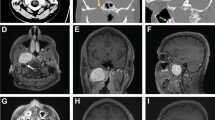Abstract
Background
The foramen rotundum and anterior cavernous sinus have traditionally been accessed by transcranial approaches that are limited by the high density of critical neurovascular structures. The transmaxillary approach provides an entirely extradural route to the foramen rotundum and anterior cavernous sinus.
Method
This patient with neurofibromatosis and facial pain with trigeminal schwannoma at the foramen rotundum was successfully treated by transmaxillary resection of the tumor. This approach allowed for a direct extradural access to the pathology, with bony decompression and tumor resection, avoiding transcranial routes.
Conclusion
The transmaxillary approach provides a safe and entirely extradural corridor to access smaller localized skull base lesions at and surrounding the cavernous sinus.



Similar content being viewed by others
Data availability
All data and material are included in the paper and video.
Code availability
Not applicable.
References
Couldwell WT, Sabit I, Weiss MH, Giannotta SL, Rice D (1997) Transmaxillary approach to the anterior cavernous sinus: a microanatomic study. Neurosurgery 40:1307–1311
Liu JK, Zhao K, Vazquez A, Eloy JA (2020) Combined endoscopic endonasal and sublabial transmaxillary approach for resection of giant infratemporal fossa schwannoma with intracranial extension: operative video and technical nuances. Neurosurg Focus Video 2:V16
Sabit I, Schaefer SD, Couldwell WT (2000) Extradural extranasal combined transmaxillary transsphenoidal approach to the cavernous sinus: a minimally invasive microsurgical model. Laryngoscope 110:286–291
Xue Z, Liu J, Bi ZY, Yi ZQ, Bao SD, Liu PN, Yang ZJ (2019) Evolution of transmaxillary approach to tumors in pterygopalatine fossa and infratemporal fossa: anatomic simulation and clinical practice. Chin Med J (Engl) 132:798–804
Yasuda A, Campero A, Martins C, Rhoton AL Jr, de Oliveira E, Ribas GC (2008) Microsurgical anatomy and approaches to the cavernous sinus. Neurosurgery 62:1240–1263
Acknowledgements
We thank Vance Mortimer for assistance with preparation of the video and Kristin Kraus for editorial assistance.
Author information
Authors and Affiliations
Contributions
FN: writing — original draft, visualization; AL — writing – original draft; GJA: writing — original draft; WTC: conceptualization, writing — review and editing, visualization.
Corresponding author
Ethics declarations
Ethics approval
The report was exempt from institutional ethical approval as description of a single case.
Consent to participate
The patient consented to participate.
Consent for publication
The patent consented to the publication of their case and images.
Conflict of interest
The authors declare no competing interests.
Additional information
Publisher's Note
Springer Nature remains neutral with regard to jurisdictional claims in published maps and institutional affiliations.
Key points
1. Surgical access to the anterior cavernous sinus is limited by the density of critical neurovascular structures.
2. The transmaxillary approach allows for a direct and completely extradural approach to the region of the foramen rotundum and anterior cavernous sinus.
3. The course of the maxillary nerve and its infraorbital branch serves as a guide for the approach. The maxillary division of the trigeminal nerve traverses the cavernous sinus and exits at the foramen rotundum to enter the pterygopalatine fossa, where it branches into the infraorbital nerve, which exits through the inferior orbital fissure to the roof of the maxillary sinus. Familiarity with this anatomy is paramount for this approach.
4. Risk of damage to key neurovascular structures in the anterior cavernous region, including the internal carotid artery and cranial nerves traversing the superior orbital fissure and foramen rotundum, should be discussed in detail with the patient preoperatively. The transmaxillary approach requires an experienced surgeon to minimize these risks.
5. Preoperative assessment with thin-cut computed tomography scans is recommended to assist with identification of anatomic variants before surgery. Stereotactic guidance can help confirm landmarks intraoperatively for surgeons who are less familiar.
6. The approach can be divided into three stages: maxillary, pterygopalatine, and intracranial stages.
7. In the maxillary stage, a sublabial incision and Caldwell-Luc maxillotomy are performed. The mucosa of the roof of the maxillary sinus is removed, and the infraorbital nerve is exposed throughout its course from the roof to posterior maxilla and followed to the pterygopalatine fossa.
8. In the pterygopalatine stage, the sphenopalatine artery is identified and ligated to prevent excessive bleeding. This is well tolerated because of the robust collaterals of the nasal vasculature. The infraorbital nerve is then dissected in the pterygopalatine fossa and followed to the foramen rotundum.
9. In the intracranial stage, the bone surrounding the foramen rotundum can be carefully drilled and expanded if needed. Further access to the region of the anterior cavernous sinus by way of the anteromedial triangle can be obtained by extending the bony exposure towards the superior orbital fissure.
10. Fat grafting can be used to minimize risk of cerebrospinal fluid leak.
Supplementary Information
Below is the link to the electronic supplementary material.
Supplementary file1 (MP4 97.0 MB)
Rights and permissions
Springer Nature or its licensor (e.g. a society or other partner) holds exclusive rights to this article under a publishing agreement with the author(s) or other rightsholder(s); author self-archiving of the accepted manuscript version of this article is solely governed by the terms of such publishing agreement and applicable law.
About this article
Cite this article
Nassiri, F., Liang, A., Agnoletto, G.J. et al. Transmaxillary approach for resection of maxillary division trigeminal schwannoma at foramen rotundum. Acta Neurochir 166, 107 (2024). https://doi.org/10.1007/s00701-024-05996-1
Received:
Accepted:
Published:
DOI: https://doi.org/10.1007/s00701-024-05996-1




